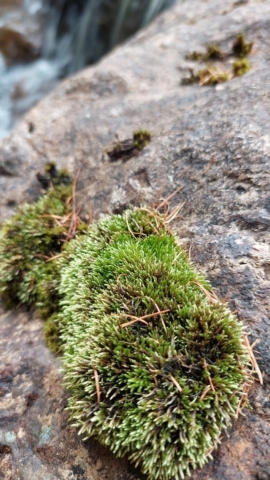Peter Bullard and I met up with a larger group of lichenologists for our field trip to Alcock Tarn. Parking in free parking areas in quarries on the minor road above the A592, we walked up the road and were soon climbing in sunshine on a good track. Alcock Tarn is at the far end of the monad, so we had a whole monad of footpath and surrounding areas to record in a single recording sheet, always something of a relief. We soon stopped to admire lichens and bryophytes on small rock faces by the track, including Bryum capillare, Orthocaulis floerkei, Andreaea rupestris, Racomitrium fasciculare and Racomitrium heterostichum. The track itself had good quantities of Polytrichum piliferum, with its distinctive hyaline hair point, and small Oligotrichum hercyanum, quite a common moss but restricted to acid soils in upland districts, where it is often seen on footpaths and tracks. Always lovely to see, it is clearly recognisable under a hand lens by its frilled ruff of wavy ridges (lamellae), often hiding within the inrolled margins of the leaf. In the same family, we later found Pogonatum aloides and Pogonatum urnigerum, which was a good opportunity to compare the features of the different species.
The lichenologists were having a lengthy tutorial session, so Peter and I decided to move on up the track. We found further boulders and rock faces, with an interesting small, dark Marsupella emarginata, which we speculated might be var pearsonii. Sadly, later examination suggested that the commoner (even ubiquitous) var. emarginata was more likely, as the pigment was dark brown without clearly reddish tints, and there was no sign of any apiculate lobes. The same rock did however have a nice example of Scapania compacta and Andreaea rothii.
Higher up, the path crossed a small beck which provided some good bryophyte habitats. Where the beck went under the bridge there was plenty of golden Sciuro-hypnum plumosum, Hygrohypnum luridum with abundant sporophytes and Rhynchostegium riparioides. Further down the beck was Chiloscyphus polyanthos s.l. a lovely patch of shiny Bryum julaceum on a rock, while an old tree had Lejeunea lamacerina, Metzgeria furcata and Frullania dilatata. At this point we were joined by Georgia Stephens, the new Rainforest advisor with Plantlife, who had come to learn more about bryophytes in the region, so we ran through some of our finds and headed up to the tarn, where we stopped for lunch.
The tarn was enlarged in the 19th century with a stone and earth dam and has a fair amount of infrastructure, including a concrete outlet. This had abundant golden Sciuro-hypnum plumosum, while in the wetter parts at the base we found Dichodontium flavescens, Pellia epiphylla, Conocephalum conicum, and a small Fissidens which turned out to be Fissidens bryoides. There was a boggy area around beck exiting the tarn, which we scoured for Sphagnum. We eventually found a few patches by the beck, and went through the Sphagnum Field Guide key, identifying S. palustre, S. rubellum and S. subnitens, growing with Aulacomnium palustre. Among the hummocks of molinia we also found Calypogeia arguta and Plagiomnium elatum.
The afternoon was wearing on so we headed back to the car, meeting some lichenologists on the way. We didn’t have a very long list, but we’d had a very pleasant afternoon and done a lot of useful revision and consolidation!
Text: Clare Shaw
Photos: Clare Shaw and Peter Bullard



